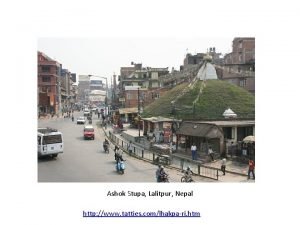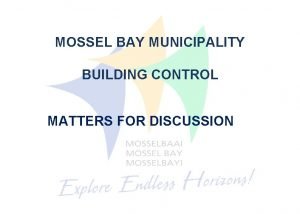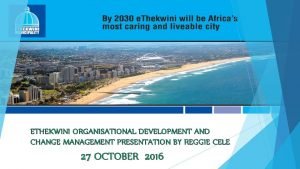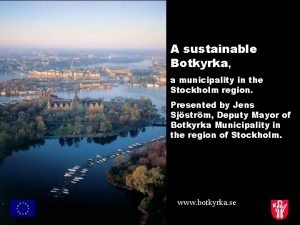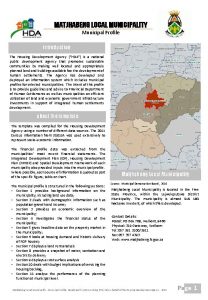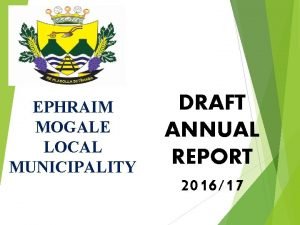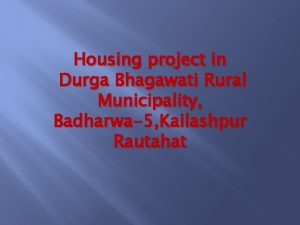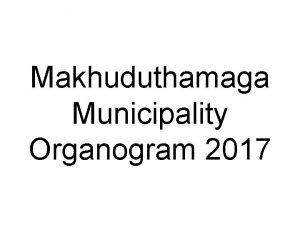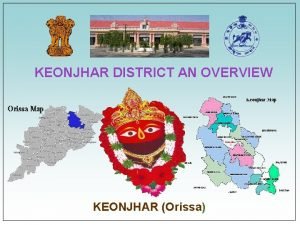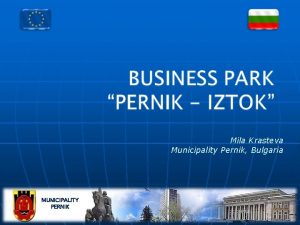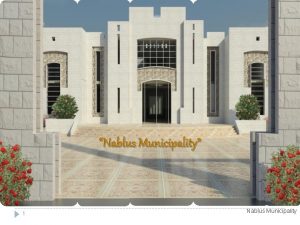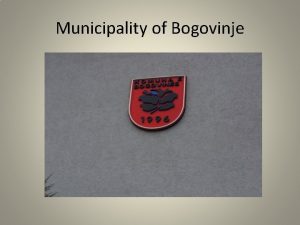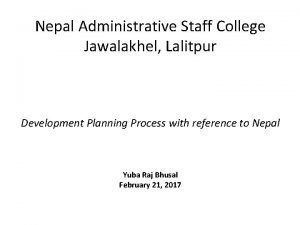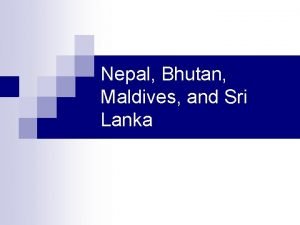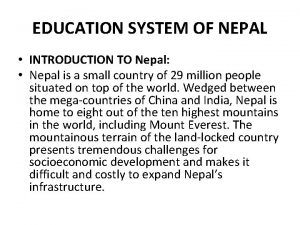Government Of Nepal Mahalaxmi Municipality Lalitpur In nepal











- Slides: 11

Government Of Nepal Mahalaxmi Municipality, Lalitpur In nepal there are 191 municipalities and 21 municipalities are in Kathmandu valley. The Mahalaxmi municipality is one of the big one of them in kathmandu valley. Malaxmi municipality is located at Southeast of Kathmandu Valley. It is composed of five VDC, s from which three are urbanising and two rural. This is decleared a Municipality one year before in 2014 december. The boundry of municipality is shared with six municipality inculding Kathmandu Metropolitan City. Municipality occupied 23 sq. km. area. It is divided into 19 Wards.

Demography of the Municipality: According to National Census 2011, total population of the municipality is 62172 with 31071 male and 31101 female. Now population of the municipality is around 100 thousand. It has 14930 household acordinng mentioned census , with average household size is 4. 26 person. Population distribution among diffirent age group shows that majority of population (69%) are inbetween the age of 15 -59 years.

Housing: Ownership of the building Within total houses the 65% have their own 33 % are in rent 0. 7% are Institutional and 0. 6% are others category. Foundation of the building: In Mahalaxmi Municipality 30% houses are build mud bonded brick/stone, 37% are cement bonded, 30% are RCC with pillar and rest are other category houses. Roof of the building 69% houses are made of RCC, 15% are Glvanised Iron, 10% are Tile/Slate and 1% are Thatch Straw.

Socio-Cultural Status Average literacy rate of Municipality is 82% of which male 91% literate and women are 73%. Municipality have two traditional cities named Luvu and Siddhipur where lives more than 80% Newari settlement with traditional cultural. In other three cities there are majority of Chetri and Bramin settlement with mixed cultural. Economic Status • • • 3% of households own four wheeler motor/ vehicle and 35% of households own motorcycle which means most of the people are using public transport. Regarding other media facilities, around 60% of households have television. However, only 32% household have computer in their home and only 12% have internet facility. Most of the households have mobile phone but only 30% of house have landline phone 14% of households are still using firewood for cooking whereas 80% of households are using LP Gas ( table 9). About 82% of households have flush toilet, however 0. 7% of households still don't have toilet in their house. About 90% are employed and self employed on low income.

Physical Infrastrucure • • Road density 0. 009772342, low coverage and black topped road are very few. Water Supply- taped pipe water supply coverage only on 42%, natural well/kuwa ( ground water) coverage 24% , Tubewell/ Hand pump 2% and rest are oters. Electricity- about 97% people is using electricity for lighting purpose yet 0. 8%household using kerosene for lighting. Poor condition of Drainage system, Solid waste management, Road width and publicle vehicle for transportation. Social- Infrastructure • Hospital, Health Post, School, College, Community building, Police station • Kist Medical College Teaching Hospital • Land use and land cover composition, topography, river, land Pooling, housing, apartment

Town/City Planning: issues • he town planning in Nepal has evolved eminently over the past five and half decades. The early town planning initiatives in the late Sixties focused on physical development plans. Since the 1990; the integrated action plans remained as a major tool of town planning. In the 2000 s and onward, the town planning constituted the strategic and periodic plans. • Throughout the planning period, the government has continued efforts to build urban infrastructure, but these have lagged behind the rapid growth of urban population. The National Urban Policy, proposes to enhance the capacity of municipalities to plan and manage integrated local development activities and recognizes the investments being inadequate to the urban growths. • The current urban plan emphasis on inclusive development and to increase public expenditure for building infrastructure. The main and Crucial challenges of the urban sector is to manage the basic infrastructure, raising municipal revenue and mobilizing it properly and managing haphazard and uncontrolled growth of urban settlements. "

Rationale of the concept note: • The existing "Period Planning Process" proved less effective in planned development of towns/cities. In this context, Mo. FALD has already started to address planned development and adoption of structure plan • Planning for resilient towns/city development involves efforts to put together the human and physical resources to build a sustainable future of people living in the towns/cities. After the severe earthquake of April 25, 2015 and visible impacts of climate change, There is compulsory to adopt plan of action for better resilient cities and towns. • "To address this situation, Go. N has drafted National Urban Development Strategy (NUDS) 2015 to restore urban planning and guide the urban growth in the days to come. The strategy contains strategic actions and proposals land use, city recreation, road infrastructure, industrial development, housing, waste disposal, water supply and health and educational facilities making cities resilient, livable, and economically sustainable. The effective implementation of NUDS may turn the cities into successful urban areas to generate employment, wealth and provide high living standards for its residents".

City Development Strategy: The City Development Strategies of Mahalaxmi is yet to be evolved so this is the first draft concept note for planned development is yet to be discussed with city stakeholders. This concept note will be shared and widely discussed in the consultative workshops of city stakeholders, local political parties, and government line agencies, NGOs, CBOs, academia, youth, women groups and other social entrepreneurs. The key components are proposed as following: Defining a Common City Vision of the Municipality • Defining city vision seems to be a fashion among planning professionals. However, this process is actually the starting point for journey for planned development to achieve the overarching goals of city by all city stakeholders. • The proposed vision of the Mahalaxmi Municipality would be "City of Eco. Tourism". The city is in the vicinity of capital city -Kathmandu, which is a tourist hot spot and Mahalaxmi has tremendous bio-diversity along its high hill located to south. It has huge potential for bird watching, hiking, trekking, study of biodiversity, and Jungle walk. This municipality can be developed as a high resilient city to climate change impacts.

Developing Structural/Indicative Plan • The urbanization process and development of city need to be urgently oriented towards planned development efforts. Thus it is obvious that the municipality should prepare and agree upon the fundamental planning interventions and these are a) preparing land use plan (including CBD), b) city road network plan, d) city drainage network plan, e) delineation of public lands and f) establishing a strong building code system. These plans, based on Nepalese experience, are critical to start from very beginning of declaration of municipality to achieve the overarching goals of city. Developing City Investment Plan: • Municipality will have a Revenue Improvement Action Plan (RIAP) by creating a systematic discussion of taxpayer’s especially urban land house tax (property tax), business tax and fees. Formulate Eco-Tourism Development Plan: • The municipality in coordination with ministry of culture and tourism, Local Chamber of Commerce, Department of Forestry, Tourism Association of Nepal and local entrepreneurs/people will prepare "Eco-Tourism Development Plan. This plan will encompass skills training, trail development, view tower development, and conservation of bio diversity.

Basic Urban Services Plan: • "Urban Basic Services Plan" will be developed in wider participation of local political parties, government line agencies, NGOs, CBOs and clubs. • Drinking water supply, household waste management, community facilities and vital registration will be priority issues. Infrastructure is the main driver of municipal /urban economy, as it includes strategic assets such as basic and utility infrastructure (transport and communications, drinking water, electricity, sewerage management, waste management, etc. ), buildings, and structures necessary for the production and delivery of goods and services. Upgrading of urban infrastructures in Mahalaxmi municipality will promote the fast development of Eco-tourism, urban periphery agriculture and overall local/urban economy. Municipal Adaptated Plan of Action (MAPA): • National Urban Development Strategy (NUDS) has enlisted specific strategies to foster resilience. The National Adaptation Plan of Action (NAPA) has also enlisted strategies separately for all key thematic areas. The strategies of NAPA and National Urban Development Strategy (NUDS) will be incorporated for fostering resilience of the urban settlements including the municipalities. However, MAPA will be incorporated in municipal periodic plan.

The Way forward This concept note will be further enriched and put into annual budget and program of coming fiscal year 2015/16 of Mahalaxmi Municipality for approval. After approval of budget by municipal council, the municipality will develop all the above mentioned planning initiatives in coming fiscal year and implement accordingly. Thank you Presented by: Krishna Prasad Sapkota Municipal Chief/ Executive Officer
 Mahalaxmi municipality
Mahalaxmi municipality Ashok stupa lalitpur
Ashok stupa lalitpur Lighthouse kvarnholmen
Lighthouse kvarnholmen Mossel bay municipality building plans
Mossel bay municipality building plans Ethekwini municipality senior management structure
Ethekwini municipality senior management structure Stockholm municipality
Stockholm municipality Matjhabeng municipality manager
Matjhabeng municipality manager Ephraim mogale local municipality councillors
Ephraim mogale local municipality councillors Municipality of anchorage procurement
Municipality of anchorage procurement Durga bhagwati rural municipality
Durga bhagwati rural municipality Organogram of theewaterskloof municipality
Organogram of theewaterskloof municipality Keonjhar district village map
Keonjhar district village map

